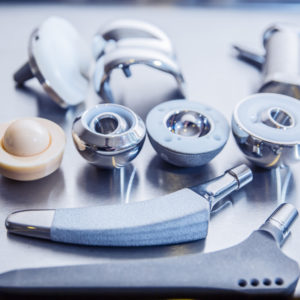Johnson & Johnson Metal Hip Lawsuit Results in Defense Verdict

The first federal bellwether trial for a DePuy Pinnacle metal-on-metal hip lawsuit has ended in a defense verdict for Johnson & Johnson, following several weeks of testimony and three days of jury deliberations.
A federal jury in Texas rejected failure to warn, defective design and negligence claims brought by Kathleen Herlihy-Paoli, whose claim was selected as the first in a series of DePuy Pinnacle trials scheduled in the federal court system to help the parties gauge how juries may respond to certain evidence and testimony that may be repeated throughout thousands of similar lawsuits pending nationwide.
Herlihy-Paoli received the Johnson & Johnson metal hip implant on both sides in 2009, and alleged that she subsequently suffered complications that were caused by the metal-on-metal design. However, attorneys for Johnson & Johnson and their DePuy Orthopaedics subsidiary argued at trial that her implant was improperly positioned by the surgeon, which they maintained was the ultimate cause of her complications and the need to have the artificial hip removed.

Learn More About
Lawsuits are being reviewed for several different dangerous and defective hip replacement systems.
Learn More About this Lawsuit SEE IF YOU QUALIFY FOR COMPENSATIONDePuy Pinnacle Hip Litigation
The trial was the first out of more than 6,500 DePuy Pinnacle hip lawsuits to go before a jury, which all involve similar arguments that the implants failed due to metallic poisoning associated with the release of microscopic metal debris as the components rub against each other during normal use.
Plaintiffs maintain that Johnson & Johnson failed to adequately warn consumers and the medical community of the risk of problems with metal-on-metal hip replacements, and that the DePuy Pinnacle hip system was defectively designed, making implants prone to fail within just a few years.
During the trial, attorneys for Herlihy-Paoli told the jury that Johnson & Johnson aggressively over-marketed the DePuy Pinnacle metal hip replacements, lied about complication rates associated with the metal-on-metal design and failed to warn people that they were being used as “guinea pigs.”
Following nearly two-months of trial in the U.S. District Court for the Northern District of Texas, where all Johnson & Johnson metal hip lawsuits involving the Pinnacle design are centralized as part of a Multi-District Litigation (MDL), the jury determined that Herlihy-Paoli failed to meet the burden of proof based on the circumstances surrounding her case.
While all of the cases involved in the DePuy Pinnacle litigation raise similar litigation, outcomes of various trials are expected to differ based on the individual circumstances in each case. The Herlihy-Paoli trial was the first in a series of three bellwether trials set to begin involving individuals who had one of the Johnson & Johnson metal hips fail, with additional trials set to begin on November 3, 2014 and January 12, 2015.
The outcomes of these bellwether trials are not binding in any other cases, but may influence potential hip replacement settlements that may be reached by Johnson & Johnson to resolve DePuy Pinnacle claims.
Johnson & Johnson Hip Settlements
The Pinnacle bellwether trial began shortly after Johnson & Johnson agreed to pay at least $2.4 billion to settle DePuy ASR hip lawsuits, resolving thousands of similar claims involving a different metal-on-metal hip that was approved as a “substantial equivalent” to the Pinnacle metal design.
A DePuy ASR recall was issued in August 2010, after the manufacturer acknowledged that the implant carried a higher-than-expected rate of failures. More than 12,000 lawsuits over DePuy ASR hips were filed nationwide before the settlement, and the agreement was only reached after a number of cases went to trial, with conflicting results.
Despite the DePuy ASR settlement, Johnson & Johnson has maintained that it intends to defend the safety of the Pinnacle implant at trial. However, early evidence in the Herlihy-Paoli trial suggests that the manufacturer knew about the risk of metal poisoning with Pinnacle hips as early as 2001, ignoring recommendations that the implants be tested to see whether they release metal debris into the bloodstream.
Other manufacturers of metal-on-metal implants face similar allegations that they failed to adequately research the design or warn about the risk of problems. Additional MDLs have been established in the federal court system for Biomet M2A Magnum metal hip lawsuits and Wright Medical Conserve Cup metal hip lawsuits.
In January 2013, the FDA released new guidance for metal-on-metal hip replacements, indicating that doctors should only use the design if other artificial hip implants are not appropriate. The agency also determined that future metal-on-metal hip designs will be required to undergo extensive human clinical trials before they will be approved.
Want a weekly update on top lawsuits, recalls & warnings?
"*" indicates required fields
1 Comments






KathleenOctober 25, 2014 at 2:36 am
I think they picked the wrong kind of case to present. I had the pinnacle put in Dec.2007. My recovery seemed to be going great. After 4 months I tried going back to my job full-time as a letter carrier. Instead of any improvement, I just kept having more pain. I kept going to the doctor and telling him something was wrong. Went through the blood test. OK. They did a bone scan, said in con[Show More]I think they picked the wrong kind of case to present. I had the pinnacle put in Dec.2007. My recovery seemed to be going great. After 4 months I tried going back to my job full-time as a letter carrier. Instead of any improvement, I just kept having more pain. I kept going to the doctor and telling him something was wrong. Went through the blood test. OK. They did a bone scan, said in conclusive. By Oct I told doctor You got to do something. I am going to loose my career, my house , everything. I hadn't worked since July because he came up with the theory, no weight bearing for 8 weeks. The post office wouldn't let me work even light duty. I went without pay for months. Finally had re vision surgery. The doctor said stem was just hanging there loose. It hadn't attached at all. I had all the symptoms they keep describing. The groin and thigh pain. The more I moved the more it hurt. I had had a hip replacement in 2003 on my left hip. No problem what so ever. It was a DePuy product, but no metal liner. I expected no problem this time. But I sure was wrong. I had immediate failure. My doctor told me he had another patient that was presenting same symptoms as mine and had scheduled him for revision surgery, and was so sorry for putting me off for so long. My replacement was in 2007. My revision 2008. Already product failing right away. Why still putting in people even years later. This all really pisses me off.